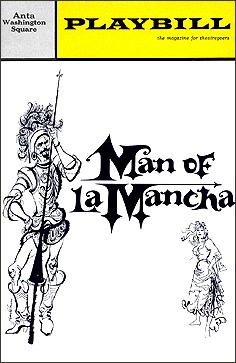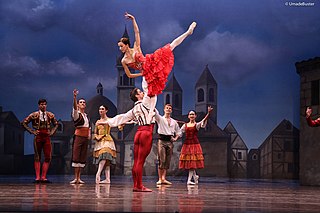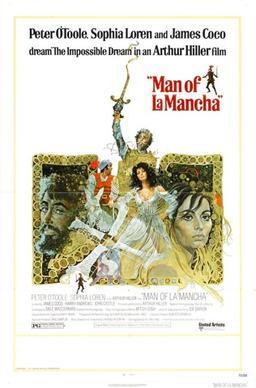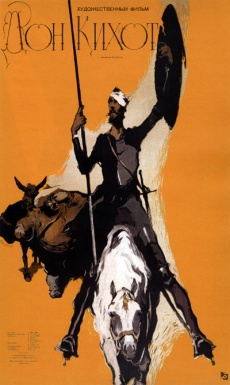Related Research Articles

Don Quixote, the full title being The Ingenious Gentleman Don Quixote of La Mancha, is a Spanish novel by Miguel de Cervantes. It was originally published in two parts, in 1605 and 1615. Considered a founding work of Western literature, it is often said to be the first modern novel. Don Quixote is also one of the most-translated books in the world and one of the best-selling novels of all time.

Man of La Mancha is a 1965 musical with a book by Dale Wasserman, music by Mitch Leigh, and lyrics by Joe Darion. It is adapted from Wasserman's non-musical 1959 teleplay I, Don Quixote, which was in turn inspired by Miguel de Cervantes and his 17th-century novel Don Quixote. It tells the story of the "mad" knight Don Quixote as a play within a play, performed by Cervantes and his fellow prisoners as he awaits a hearing with the Spanish Inquisition. The work is not and does not pretend to be a faithful rendition of either Cervantes' life or Don Quixote. Wasserman complained repeatedly about people taking the work as a musical version of Don Quixote.

La Mancha is a natural and historical region in the Spanish provinces of Albacete, Cuenca, Ciudad Real, and Toledo. It is a fertile plateau that stretches from the mountains of Toledo to the western spurs of the Cuenca hills, bordered to the south by the Sierra Morena and to the north by the Alcarria. The La Mancha historical comarca constitutes the southern portion of Castilla-La Mancha autonomous community and makes up most of the present-day administrative region.

Dulcinea del Toboso is a fictional character who is unseen in Miguel de Cervantes' novel Don Quixote. Don Quixote believes he must have a lady, under the mistaken view that chivalry requires it. As he does not have one, he invents her, making her the very model of female perfection: "[h]er name is Dulcinea, her country El Toboso, a village of La Mancha, her rank must be at least that of a princess, since she is my queen and lady, and her beauty superhuman, since all the impossible and fanciful attributes of beauty which the poets apply to their ladies are verified in her; for her hairs are gold, her forehead Elysian fields, her eyebrows rainbows, her eyes suns, her cheeks roses, her lips coral, her teeth pearls, her neck alabaster, her bosom marble, her hands ivory, her fairness snow, and what modesty conceals from sight such, I think and imagine, as rational reflection can only extol, not compare".

Sancho Panza is a fictional character in the novel Don Quixote written by Spanish author Miguel de Cervantes Saavedra in 1605. Sancho acts as squire to Don Quixote and provides comments throughout the novel, known as sanchismos, that are a combination of broad humour, ironic Spanish proverbs, and earthy wit. "Panza" in Spanish means "belly".

Alonso Fernández de Avellaneda is the pseudonym of a man who wrote a sequel to Cervantes' Don Quixote, before Cervantes finished and published his own second volume.

Plaza de España is a large square and popular tourist destination located in central Madrid, Spain at the western end of the Gran Vía. It features a monument to Miguel de Cervantes Saavedra and is adjacent to two of Madrid's most prominent skyscrapers. Additionally, the Palacio Real is only a short walk south from the plaza. After 2+1⁄2 years of renovation, on 22 November 2021, the square was reopened for pedestrians.

Don Quixote is a ballet in three acts, based on episodes taken from the famous novel Don Quixote de la Mancha by Miguel de Cervantes. It was originally choreographed by Marius Petipa to the music of Ludwig Minkus and first presented by Moscow's Bolshoi Ballet on 26 December [O.S. 14 December] 1869. Petipa and Minkus revised the ballet into a more elaborate and expansive version in five acts and eleven scenes for the Mariinsky Ballet, first presented on 21 November [O.S. 9 November] 1871 at the Imperial Bolshoi Kamenny Theatre of St. Petersburg.
I, Don Quixote is a non-musical play written for television and directed by Karl Genus. It was broadcast in season 3 of the CBS anthology series DuPont Show of the Month on the evening of November 9, 1959. Written by Dale Wasserman, the play was converted by him ca. 1964 into the libretto for the stage musical Man of La Mancha, with songs by Mitch Leigh and Joe Darion. After a tryout at Goodspeed Opera House in Connecticut, Man of La Mancha opened in New York on November 22, 1965, at the ANTA Washington Square Theatre.

Man of La Mancha is a 1972 film adaptation of the Broadway musical Man of La Mancha by Dale Wasserman, with music by Mitch Leigh and lyrics by Joe Darion. The musical was suggested by the classic novel Don Quixote by Miguel de Cervantes, but more directly based on Wasserman's 1959 non-musical television play I, Don Quixote, which combines a semi-fictional episode from the life of Cervantes with scenes from his novel.

Don Quixote or Don Quixote de la Mancha is the first sound film version in Spanish of the great classic novel by Miguel de Cervantes Saavedra. It was directed and adapted by Rafael Gil and released in 1947. A huge undertaking for Spanish cinema in its day, it was the longest film version of the novel up to that time, and very likely the most faithful, reverently following the book in its dialogue and order of episodes, unlike G.W. Pabst's 1933 version and the later Russian film version, which scrambled up the order of the adventures as many film versions do. Characters such as Cardenio, Dorotea, and Don Fernando, which are usually omitted because their respective subplots have little to do with the main body of the novel, were kept in this film.

Don Quixote is a 1957 Soviet drama film directed by Grigori Kozintsev. It is based on Evgeny Schwartz's stage adaptation of Miguel de Cervantes's novel of the same name. It was entered into the 1957 Cannes Film Festival.

Don Quixote is a 1955 sketch by Pablo Picasso of the Spanish literary hero and his sidekick, Sancho Panza. It was featured on the August 18–24 issue of the French weekly journal Les Lettres Françaises in celebration of the 350th anniversary of the first part, published in 1605, of the Miguel de Cervantes novel Don Quixote. Made on August 10, 1955, the drawing Don Quixote was in a very different style than Picasso’s earlier Blue, Rose, and Cubist periods.

Donkey Xote is a 2007 animated children's film produced by Lumiq Studios. A co-production between Spain and Italy, the film is directed by José Pozo and written by Angel Pariente, based on the Miguel de Cervantes novel Don Quixote, and features the voices of Andreu Buenafuente, David Fernández, Sonia Ferrer and José Luis Gil. The film has gained notoriety as a mockbuster as the lead character Rucio bears an intentional resemblance to Donkey from the Shrek film series, along with the poster and trailer having the tagline "From the producers who saw Shrek".
Don Quijote cabalga de nuevo is a 1973 Spanish-Mexican comedy film directed by Roberto Gavaldón, loosely based on Miguel de Cervantes's novel Don Quixote and starring Cantinflas as Sancho Panza, Fernando Fernán Gómez as Don Quixote, and María Fernanda D'Ocón as Dulcinea.
Don Quixote is a 1923 British silent comedy film, directed by Maurice Elvey, based on the novel Don Quixote by Miguel de Cervantes. The film stars Jerrold Robertshaw, George Robey, Frank Arlton, and Marie Blanche.
Don Quixote is a 2015 American adventure drama film starring Carmen Argenziano, Horatio Sanz, Luis Guzman, James Franco, Lin Shaye and Reinaldo Zavarce. It is based on the novel of the same name by Miguel de Cervantes.

Don Quixote, Knight Errant is a 2002 Spanish adventure film directed and written by Manuel Gutiérrez Aragón, consisting of an adaptation of the second part of Miguel de Cervantes' Don Quixote. It stars Juan Luis Galiardo and Carlos Iglesias respectively as Don Quixote and Sancho Panza, alongside Santiago Ramos, Fernando Guillén Cuervo, Manuel Manquiña, Kiti Manver, Manuel Alexandre, Juan Diego Botto and Emma Suárez.
References
- ↑ Classical Archives
- ↑ Seraphim Records LP reissue
- ↑ "Don Quichote". festival-cannes.com. Retrieved 25 July 2009.
- ↑ amazon.com
- ↑ Harper, Sue (1994). Picturing the past : the rise and fall of the British costume film . BFI Publishing. p. 39.